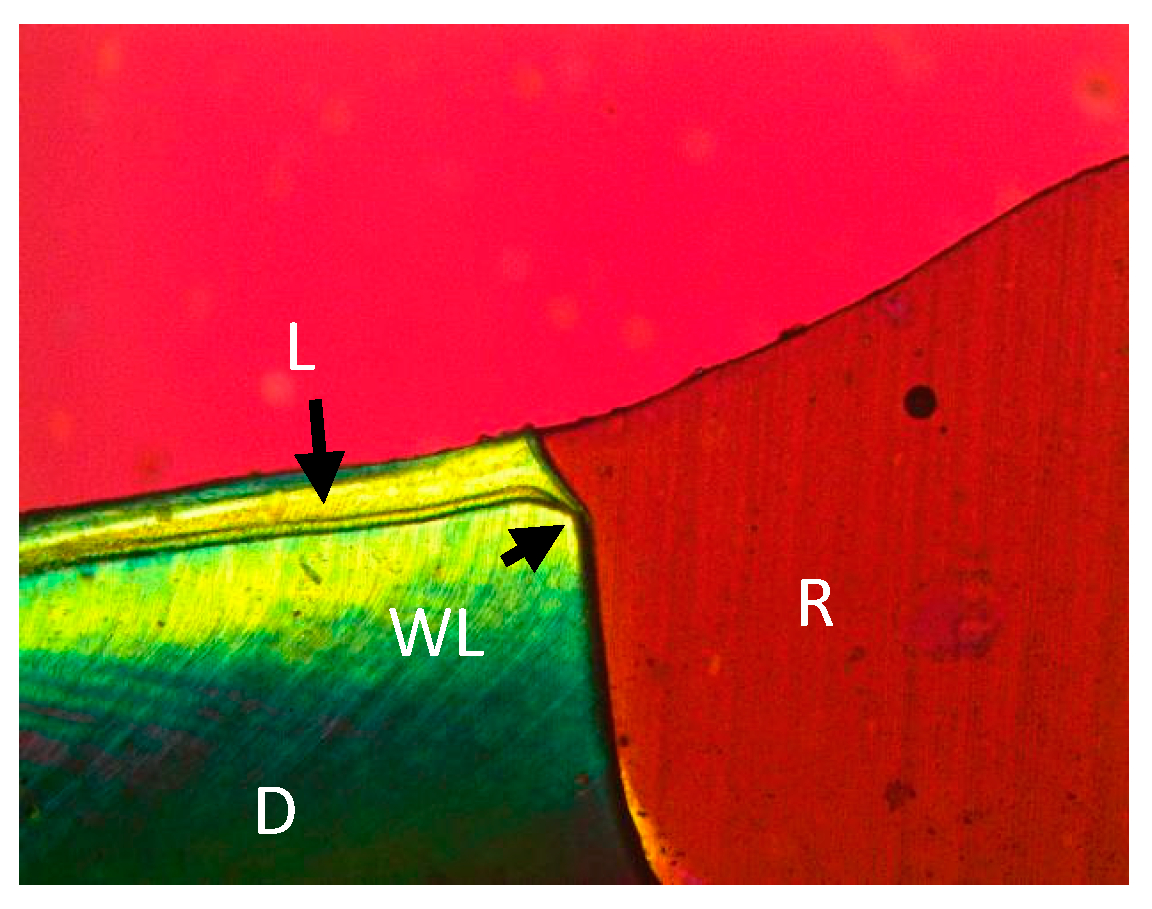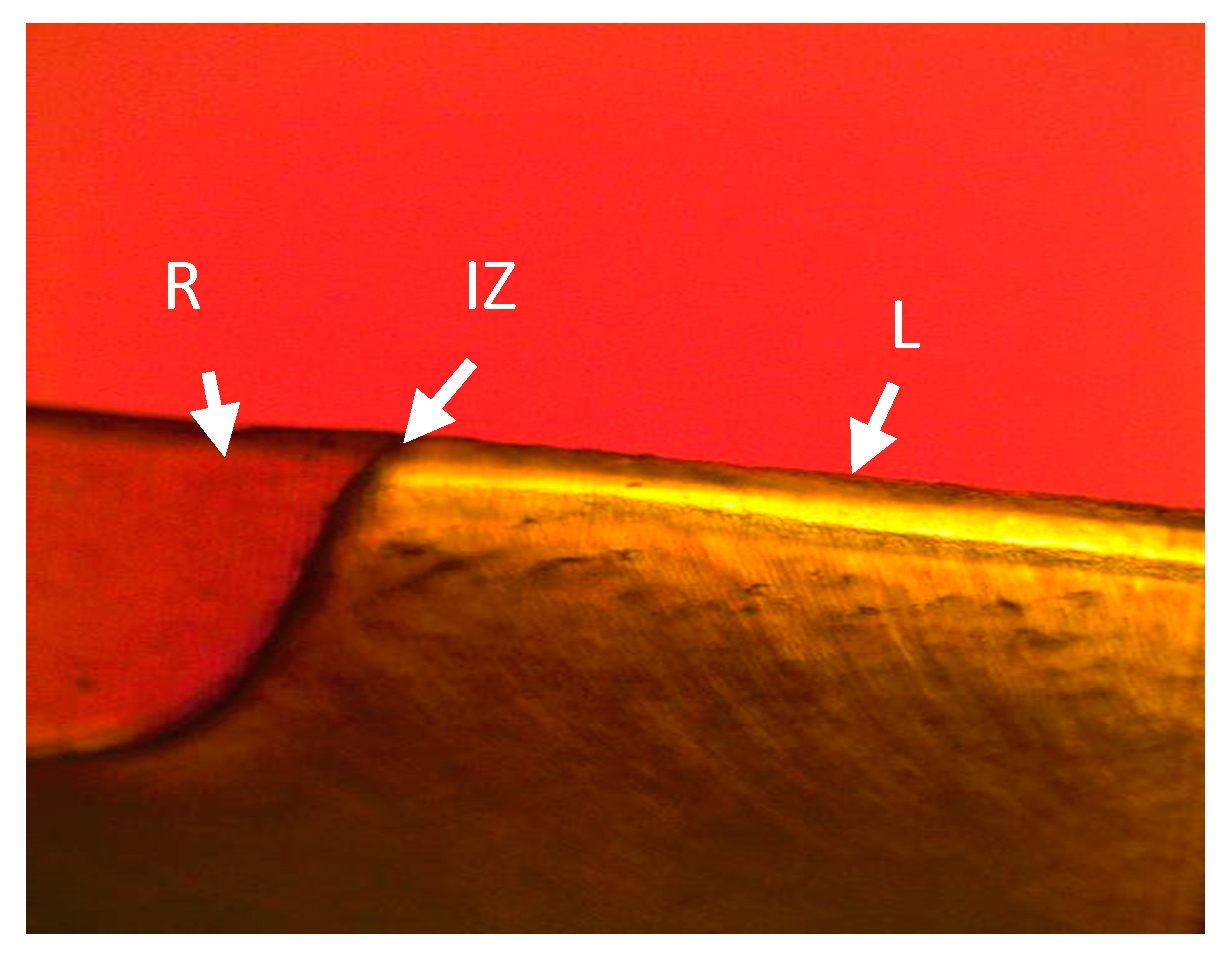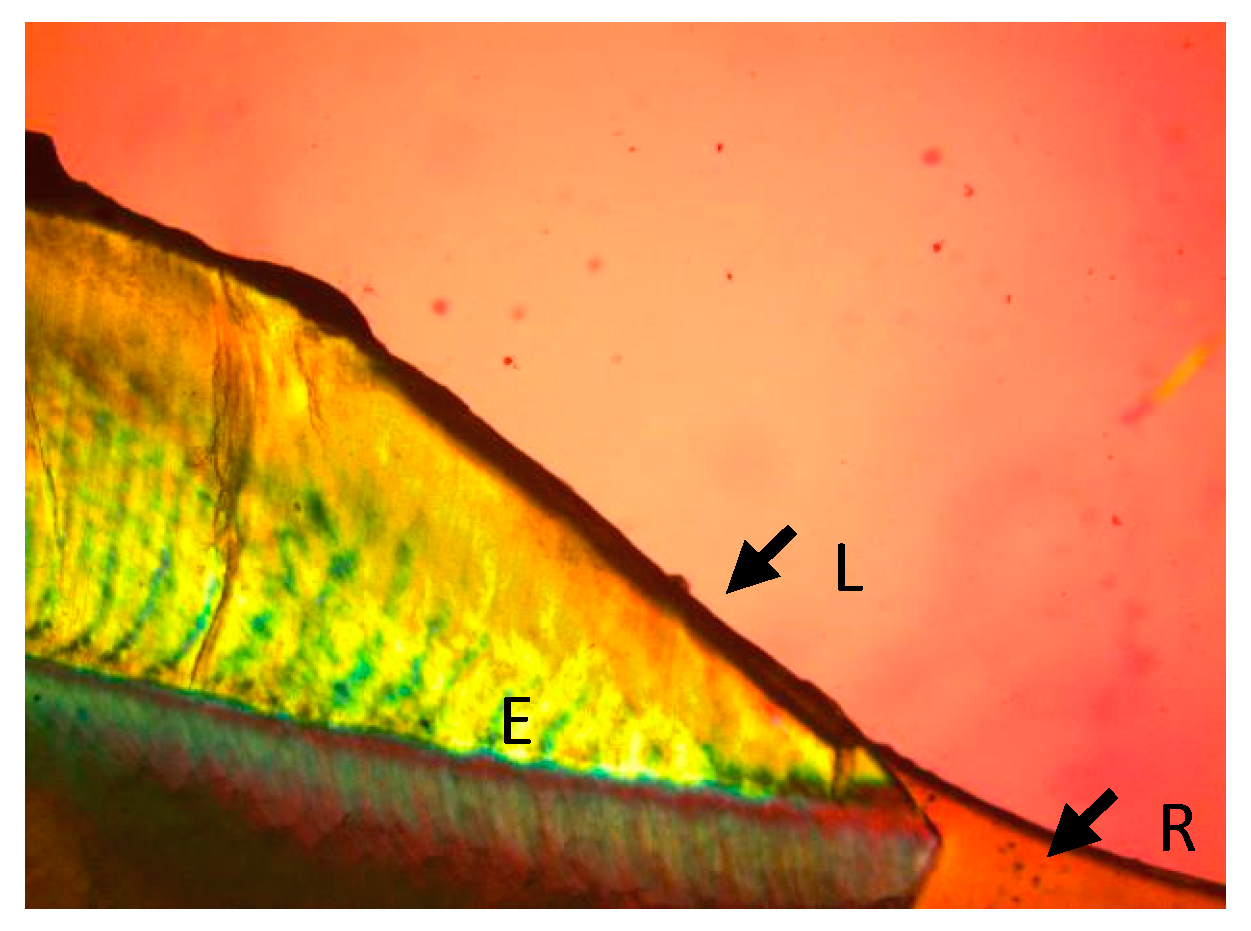Inhibition of Demineralization at Restoration Margins of Z100 and Tetric EvoCeram Bulk Fill in Dentin and Enamel
Abstract
1. Introduction
2. Materials and Methods
3. Results
4. Discussion
5. Conclusions
Author Contributions
Funding
Conflicts of Interest
References
- National Institute of Dental and Craniofical Research. Dental Caries. Available online: https://www.nidcr.nih.gov/research/data-statistics/dental-caries (accessed on 8 January 2019).
- A Mjör, I.; Toffenetti, F. Placement and replacement of resin-based composite restorations in Italy. Oper. Dent. 1992, 17, 82–84. [Google Scholar] [PubMed]
- Nedeljkovic, I.; Teughels, W.; De Munck, J.; Van Meerbeek, B.; Van Landuyt, K.L. Is secondaty caries with composites a materialbased problem? Dent. Mat. 2015, 31, e247–e277. [Google Scholar] [CrossRef] [PubMed]
- May, E.; Donly, K.J. Fluoride resealse and re-release from a bioactive restorative material. Am. J. Dent. 2017, 30, 305–308. [Google Scholar]
- Khvostenko, D.; Hilton, T.J.; Ferracane, J.L.; Mitchell, J.C.; Kruzic, J.J. Bioactive glass fillers reduce bacterial penetration into marginal gaps for composite restorations. Dent. Mat. 2016, 32, 73–81. [Google Scholar] [CrossRef] [PubMed]
- Donly, K.J.; Liu, J.A. Dentin and enamel demineralization inhibition at restoration margins of Vitremer. Am. J. Dent. 2018, 31, 166–168. [Google Scholar]
- ten Cate, J.M.; Dujisters, P.P. Alternating demineralization and remineralization of artificial enamel lesions. Caries Res. 1982, 16, 201–210. [Google Scholar] [CrossRef] [PubMed]
- Gonzalez, E.D.H.; Yap, A.U.J.; Hsu, S.C.Y. Demineralization inhibition of direct tooth-colored restorative materials. Oper. Dent. 2004, 29, 578–585. [Google Scholar]
- Savarino, L. Ability of restorative and fluoride releasing materials to prevent marginal dentine demineralization. Biomaterials 2004, 25, 1011–1017. [Google Scholar] [CrossRef]
- Donly, K.J.; Grandgenett, C. Dentin remineralization inhibition at restoration margins of Vitremer, Dyract and Compoglass. Am. J. Dent. 1998, 11, 245–248. [Google Scholar] [PubMed]
- Donly, K.J. Enamel and dentin demineralization inhibition of fluoride-releasing materials. Am. J. Dent. 1994, 7, 275–278. [Google Scholar] [PubMed]
- Takeuti, M.M.; Marquezan, M.; Rodrigues, C.R.; Rodrigues Filho, L.E.; Rocha Rde, O. Inhibition of demineralization adjacent to tooth-colored restorations in primary teeth after 2 in vitro challenges. J. Dent. Child 2007, 74, 209–2014. [Google Scholar]
- Xu, H.; Moreau, J.; Sun, L.; Chow, L. Novel CaF2 Nanocomposite with High Strength and Fluoride Ion Release. J. Dent. Res. 2010, 89, 739–745. [Google Scholar] [CrossRef]
- Singhal, R.K.; Rai, B. Remineralization Potential of Three Tooth Pastes on Enamel Caries. Open Access Maced. J. Med. Sci. 2017, 5, 664–666. [Google Scholar] [CrossRef] [PubMed]




| Enamel Tetric | Enamel Z100 | Dentin Tetric | Dentin Z100 |
|---|---|---|---|
| 0.0000 | 4541.0000 | 3918.0000 | 4567.0000 |
| 1692.0000 | 1710.0000 | 3233.0000 | 3347.0000 |
| 1576.0000 | 3323.0000 | 3429.0000 | 3179.0000 |
| 2164.000 | 1733.0000 | 2444.0000 | 5270.0000 |
| 3766.0000 | 3418.0000 | 2663.0000 | 3662.0000 |
| 0.0000 | 3740.0000 | 2984.0000 | 3786.0000 |
| 2465.0000 | 2879.0000 | 2653.0000 | 4923.0000 |
| 2043.0000 | 1950.0000 | 2524.0000 | 4273.0000 |
| 1546.0000 | 1743.0000 | 2753.0000 | 3201.0000 |
| 1705.0000 | 3675.0000 | 3547.0000 | |
| 0.0000 | 3810.0000 |
© 2019 by the authors. Licensee MDPI, Basel, Switzerland. This article is an open access article distributed under the terms and conditions of the Creative Commons Attribution (CC BY) license (http://creativecommons.org/licenses/by/4.0/).
Share and Cite
Leon-Pineda, C.; Donly, K. Inhibition of Demineralization at Restoration Margins of Z100 and Tetric EvoCeram Bulk Fill in Dentin and Enamel. Bioengineering 2019, 6, 36. https://doi.org/10.3390/bioengineering6020036
Leon-Pineda C, Donly K. Inhibition of Demineralization at Restoration Margins of Z100 and Tetric EvoCeram Bulk Fill in Dentin and Enamel. Bioengineering. 2019; 6(2):36. https://doi.org/10.3390/bioengineering6020036
Chicago/Turabian StyleLeon-Pineda, Cristina, and Kevin Donly. 2019. "Inhibition of Demineralization at Restoration Margins of Z100 and Tetric EvoCeram Bulk Fill in Dentin and Enamel" Bioengineering 6, no. 2: 36. https://doi.org/10.3390/bioengineering6020036
APA StyleLeon-Pineda, C., & Donly, K. (2019). Inhibition of Demineralization at Restoration Margins of Z100 and Tetric EvoCeram Bulk Fill in Dentin and Enamel. Bioengineering, 6(2), 36. https://doi.org/10.3390/bioengineering6020036




